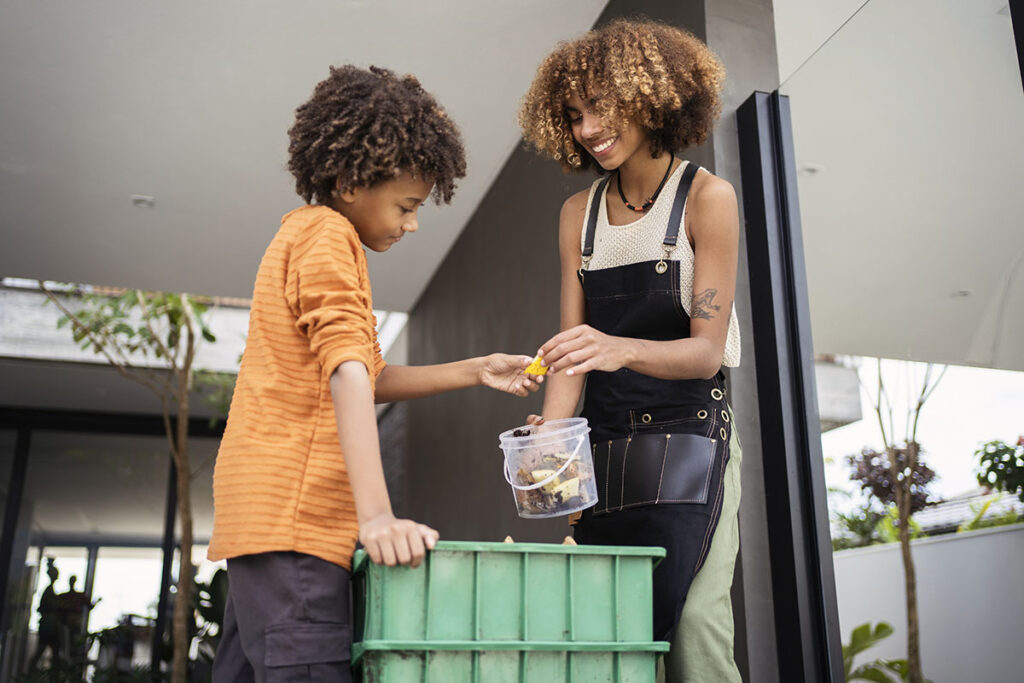Students explore the impact of food waste on our communities, focusing on how students can take action to reduce food waste. Students investigate why food is thrown away, how they can reduce the amount of food disposed of, and ensure that food waste is composted to contribute to healthy environments. Students also develop an understanding of where their food waste goes when it is thrown away instead of composted.
Students will develop an understanding of the food decomposition process, how landfilled organic waste releases greenhouse gases, and how food scraps can be used to create compost. Lessons introduce strategies that students can commit to as individuals as well as strategies that may take schoolwide effort. The unit culminates with an action plan to help students and the school community waste less food. Pairing action with learning helps students to feel empowered and hopeful.

“My students often refer to the experience and knowledge gained. I plan to use Seeds to Solutions lessons in the future.”
“The message that there are solutions to help us combat climate change and that people are working together to solve problems helped students stay in a place of curiosity; they didn’t show anxiety over the content.”
“For my students who may not engage with abstract concepts, the real-life relevance of turning waste into soil for growing plants offers a clear, meaningful goal that they can understand and feel proud to participate in.”
“WOW! What incredible and engaging lessons to do with my students. They loved this opportunity to be scientists, explore and think about the food they eat, and I loved the ways that they began to model. I am so excited about these lessons and cannot wait to share them with my coworkers.”
“I heard comments like, ‘I didn’t realize how much climate change affects my community,’ and, ‘This project made me think about what I can do to help.'”
“This lesson brought in cultural stories from the original people who inhabited California. This is a perspective that is not often taught in science. I think that the kids liked having science be a little less facts and figures and more story.”
“Students really enjoyed the hands-on activity. They were very interested to learn about the different pollutants that they’ve never heard of. It also developed their curiosity about air quality and pollution. It was an eye-opener for some that they are able to see what is mostly ‘unseen’ by everyone.”
“I love how the data was more interactive and chunked into smaller pieces. I also like how there was a way to bring all the knowledge and wondering back to come up with a conclusion to the problem.”
“The kids become more engaged because now they are actually actively doing things. They’re really having to look for themselves. It’s not given to them on a platter, but all the resources are right there.”
“They’ve never thought about stuff like this before, and now they’re sharing it. One girl said this was the only class that she went home and talked to her parents about.”
“Using the maps and seeing things like schools and how close they are to hazards is really cool. They may not be super connected personally, but they can put themselves in the shoes of other kids and try to relate. I know it’s working because I have a kid that just watches Netflix all day, every day and he pulled out his earbud and participated!”
“When you’re out in the workforce, you’re trying to solve problems that don’t have a clear, immediate answer. So doing stuff like this helps give students practice.”

Maria Nichols, San Diego USD
Meagan Nelson-Palamara, Curriculum Developer
Angelle Lailhengue, Curriculum Developer
Emily Schell, University of San Diego
Roni Jones, Ten Strands
Stephanie Buttell-Maxin, CA Global Education Project
Chelsea Cochrane, San Diego COE
Laura Tucker, Science Educator
Sandi Yellenberg, Science Educator
Matt Ellinger, Designer
Elaine Klein, BSCS
Stacey Lane, Illustrator
Evan Schell, Evan Schell Photography
Children’s Environmental Literacy Foundation
Hannah Ammerman, Santa Rosa City Schools
Louisa Bolton-Ast, Round Valley School District
Kim Douillard, Cardiff School District
Stefanie Freele, West Side UESD
Lisa Garcia, Fremont USD
Karen Gomez, New Heights Charter School
Elena Hood, Spencer Valley ESD
Elizabeth Volmer, Jefferson ESD
Rebecca Wilcox, Los Angeles USD
You’ll get news on Seeds to Solutions and environmental literacy from Ten Strands
"*" indicates required fields
© 2025 San Mateo County Office of Education and Ten Strands | Terms of Use | Privacy Policy